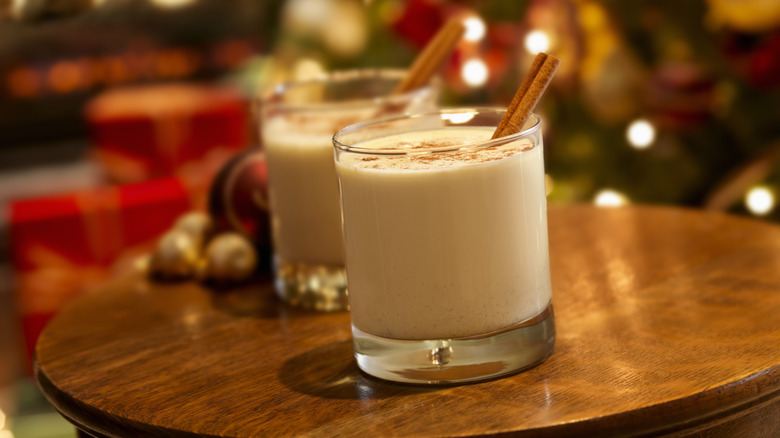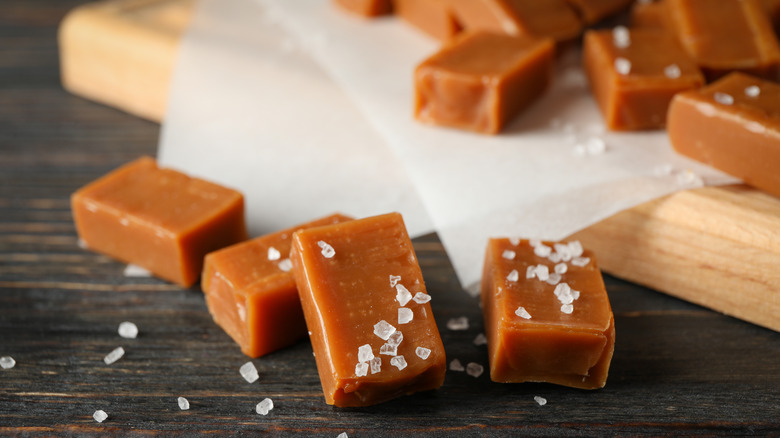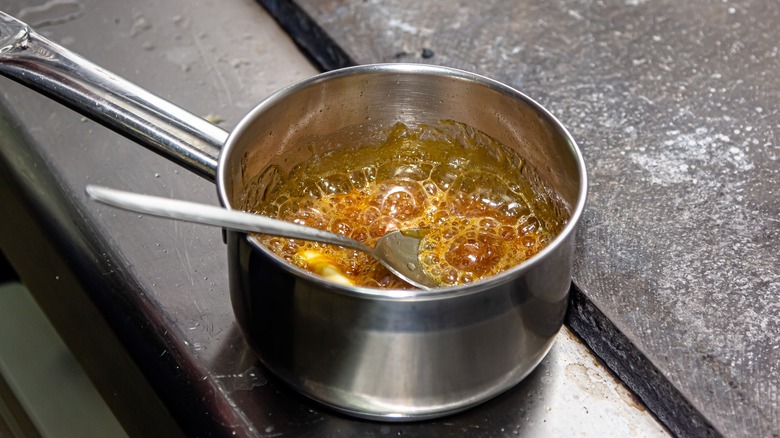For Unforgettable Homemade Caramel Candy, Just Add Some Eggnog
A beloved holiday treat, eggnog can be made from scratch or purchased from the grocery store for greater convenience. While quite enjoyable as a beverage, it also works beautifully as a base for homemade caramel candy. The rich, creamy drink infuses a butterscotch flavor into the finished candies, while also contributing to a perfectly chewy texture that makes the caramel a joy to eat.
Eggnog typically consists of milk, cream, sugar, and warming spices like nutmeg. The festive beverage also features eggs (hence the name), which can raise some concerns about food safety. Fortunately, many versions typically include pasteurized eggs, which alleviate any safety risks. With pasteurized eggs, heat is applied to the shells to effectively eliminate any bacteria that may contribute to illness associated with consuming raw eggs, according to the USDA. As a result, storebought eggnog safely offers the taste that holiday revelers know and love. If you find yourself with a few cartons hanging around your fridge, why not try your hand at making homemade caramel candy?
Why eggnog makes the perfect base for caramel candy
While there are many variations to homemade caramel candy recipes, some use condensed milk as a base. Condensed milk is a thicker, sweeter form of regular milk that's used in lots of baked goods and desserts. Along with incorporating condensed milk to add some silky sweetness, additional caramel candy ingredients usually include sugar (brown and white), butter, salt, and corn syrup. You can make chewy salted vanilla caramels, for instance, with heavy cream.
Eggnog-based caramel candy includes many of the same ingredients as traditional preparations but replaces condensed milk or heavy cream with eggnog. This swap positively affects the flavor of the finished recipe due to the richness of eggnog. While somewhat similar in texture to condensed milk, eggnog also features notes of vanilla and spices. These extras create a more complex caramel flavor than is possible with many traditional recipes. Eggnog is also a more convenient option, as it allows you to skip the brown sugar and vanilla that's often called for in traditional caramel preparations.
Tips for enjoying homemade caramel candy
Candy making isn't typically considered a dangerous activity, but caramel does carry a burn risk due to the high temperatures and sticky textures. According to the Washington State Department of Social and Health Services, a liquid with a temperature of 140 degrees Fahrenheit can cause a burn injury in less than five seconds. Depending on the type of caramel you're making (caramel candy can have a taffy-like consistency or it may be similar to toffee), temperatures can range from 240 degrees to 320 degrees Fahrenheit. Accordingly, it's best to take some helpful safety precautions when making caramel at home, like using a candy thermometer and wearing long sleeves to protect your arms while cooking.
As for what to do with your caramel candies once they're finished, there are lots of fun applications. Along with enjoying them on their own, you can also add them to snickerdoodles, where they'll incorporate a bit of sweetness into the delightfully spicy cookie. If you're tired of the same old sweeteners, homemade caramel candies make the perfect alternative. In this case, add caramel to coffee to create a delicious hot beverage that rivals what's available at big coffee chains. With such a simple recipe at your disposal, you're sure to find lots of uses for homemade caramel treats.


